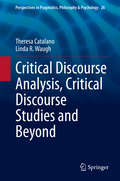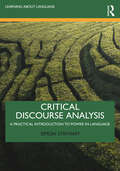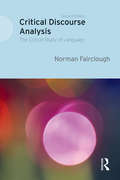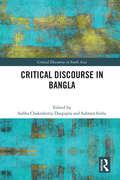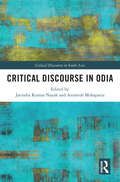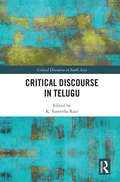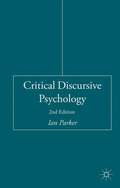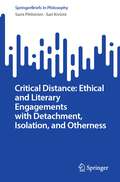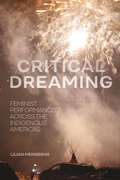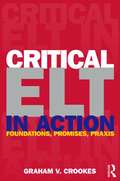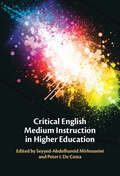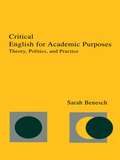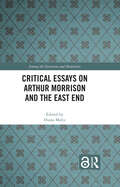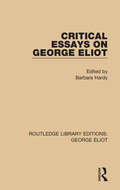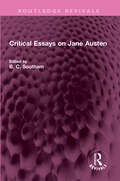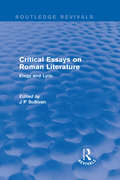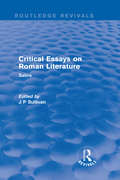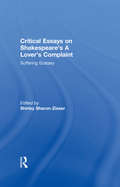- Table View
- List View
Critical Discourse Analysis, Critical Discourse Studies and Beyond (Perspectives in Pragmatics, Philosophy & Psychology #26)
by Linda R. Waugh Theresa CatalanoThis book explores the problem-oriented interdisciplinary research movement comprised of Critical Discourse Analysis (CDA) and Critical Discourse Studies (CDS) for scholars, teachers, and students from many backgrounds. Beginning with a Preface by renowned CDA/CDS scholar Ruth Wodak, it introduces CDA/CDS through examples of what its research looks like, delineates various precursors to CDA/CDS and important foundational concepts and theories, and traces its development from its early years until it became established. After the relationship between CDA and CDS is discussed, seven commonly cited approaches to CDA/CDS are outlined, including their connections and differences, their origins and development, major and associated scholars, research focus(es), and central concepts and distinguishing features. After a summary of critiques of CDA/CDS and responses by CDA/CDS scholars, the book provides an overview of its salient connections to other interdisciplinary areas of scholarship such as critical applied linguistics, education, anthropology/ ethnography, sociolinguistics, gender studies, queer linguistics, pragmatics and ecolinguistics. The final chapter describes how scholars use their knowledge of CDA/CDS to make a difference in the world.
Critical Discourse Analysis: A Practical Introduction to Power in Language (Learning about Language)
by Simon StathamThis book provides a comprehensive account of the discipline of Critical Discourse Analysis (CDA) and demonstrates multiple linguistic methods through which it exposes and demystifies ideologies that are present in institutional discourse. The book enables readers to critique the complexities of the relationship between language and power to expose the ideological operation of discourse. Proceeding from a theoretical grounding for CDA in contemporary society, the book comprises analysis of a wide range of discourse examples, including the news media, political speeches, public service leaflets and social media. Readers are guided through a diverse range of models in CDA in order to scrutinise and assess the role of language in society and to consider and challenge the principles of powerful networks, institutions and organisations.
Critical Discourse Analysis: The Critical Study of Language (Critical Discourse Analysis Ser.)
by Norman FaircloughBringing together papers written by Norman Fairclough over a 25 year period, Critical Discourse Analysis represents a comprehensive and important contribution to the development of this popular field. The book is divided into seven sections covering the following themes: language in relation to ideology and powerdiscourse in processes of social and cultural change dialectics of discourse, dialectical relations between discourse and other moments of social lifemethodology of critical discourse analysis research analysis of political discourse discourse in globalisation and 'transition' critical language awareness in education The new edition has been extensively revised and enlarged to include a total of twenty two papers. It will be of value to researchers in the subject and should prove essential reading for advanced undergraduate and postgraduate students in Linguistics and other areas of social science.
Critical Discourse in Bangla (Critical Discourses in South Asia)
by Subha Chakraborty Dasgupta Subrata SinhaThis volume forms a part of the Critical Discourses in South Asia series which deals with schools, movements and discursive practices in major South Asian languages. It offers crucial insights into the making of Bengali or Bangla literature and its critical tradition across a century. The book brings together English translation of major writings of influential figures dealing with literary criticism and theory, aesthetic and performative traditions and re-interpretations of primary concepts and categories in Bangla. It presents 32 key texts in literary and cultural studies from Bengal from the middle of the 19th to that of the 20th century, with most of them translated for the first time into English. These seminal essays cover interconnections with socio-historical events in the colonial and post-independence period in Bengal, including the background to the language movement in Bangladesh. They discuss themes such as integrative aesthetic visions; poetic and literary forms; modernism; imagination; power structures and social struggles; ideological values; cultural renovations; and humanism. Comprehensive and authoritative, this volume offers an overview of the history of critical thought in Bangla literature in South Asia. It will be essential for scholars and researchers of Bengali/Bangla language and literature, literary criticism, literary theory, comparative literature, Indian literature, cultural studies, art and aesthetics, performance studies, history, sociology, regional studies and South Asian studies. It will also interest the Bengali-speaking diaspora and those working on the intellectual history of Bengal and conservation of languages and culture
Critical Discourse in Gujarati (Critical Discourses in South Asia)
by Sitanshu YashaschandraThis volume forms part of the Critical Discourses in South Asia series, which deals with schools, movements, and discursive practices in major South Asian languages. It offers crucial insights into the making of Gujarati literature and its critical tradition across a century / several centuries. The book presents one of a kind historiography of Gujarati literature and of its critical discourse. It brings together English translations of major writings of influential figures dealing with literary criticism and theory, aesthetic and performative traditions, and re-interpretations of primary concepts and categories in Gujarati. It initiates an exploration into Gujarati critical discourse from the heather to neglected pre-colonial centuries and presents key texts in literary and cultural studies, some of which are being made available for the first time into English. These seminal essays explore complex interconnections understand the dynamics of critical discursive situations in Gujarati literature and to carefully construct a mobile post of observation that matches those dynamics. They offer a radical departure from the widespread historiographical practice in Indian writings of disregarding pre-colonial literary critical discourse. The book also offers a new and indigenous periodization of Gujarati literature and its critical discourse, derived from a fresh perception of Gujarati and Indian literary culture. Comprehensive and authoritative, this volume offers an overview of the history of critical thought in Gujrati literature in South Asia. It will be essential for scholars and researchers of Gujarati language and literature, literary criticism, literary theory, comparative literature, Indian literature, cultural studies, art and aesthetics, performance studies, history, sociology, regional studies, and South Asian studies. It will also interest the Gujarati-speaking diaspora and those working on the intellectual history of Gujarat and Western India and conservation of the language and their culture.
Critical Discourse in Odia (Critical Discourses in South Asia)
by Jatindra Kumar Nayak and Animesh MohapatraThis volume forms a part of the Critical Discourses in South Asia series which deals with schools, movements and discursive practices in major South Asian languages. It offers crucial insights into the making of Odia literature and its critical tradition across a century. The book brings together English translation of major writings of influential figures dealing with literary criticism and theory, aesthetic and performative traditions and re-interpretations of primary concepts and categories in Odia. It presents 25 key texts in literary and cultural studies from late 19th century to early 21st century, translated by experts for the first time into English. These seminal essays explore complex interconnections between socio-historical events in the colonial and post-Independence period in Odisha and the language movement. They discuss themes such as the evolving idea of literature and criteria of critical evaluation; revision and expansion of the literary canon; the transition from orality to print; emergence of new reading practices resulting in shifts in aesthetic sensibility; dialectics of tradition and modernity; and the formation, consolidation and political consequences of a language-based identity. Comprehensive and authoritative, this volume offers an overview of the history of critical thought in Odia literature in South Asia. It will be essential for scholars and researchers of Odia language and literature, literary criticism, literary theory, comparative literature, Indian literature, cultural studies, art and aesthetics, performance studies, history, sociology, regional studies and South Asian studies. It will also interest the Odia-speaking diaspora and those working on the intellectual history of Odisha and eastern India and conservation of language and culture.
Critical Discourse in Punjabi (Critical Discourses in South Asia)
by Rana Nayar Alpna Saini Tania BansalThis volume forms a part of the Critical Discourses in South Asia series which deals with schools, movements and discursive practices in major South Asian languages. It offers crucial insights into the making of the Punjabi language and literature, and its critical tradition across a century. The book brings together English translation of major writings of influential figures dealing with literary criticism and theory, aesthetic and performative traditions and re-interpretations of primary concepts and categories in Punjabi. It presents 30 key texts in literary and cultural studies from Punjab from the beginning of development of Punjabi language to its present form, with most of them translated for the first time into English. These seminal essays cover interconnections with socio-historical events in the medieval, colonial and post-independence period in Punjab. They discuss themes such as spiritual and aesthetic visions, poetic and literary forms, modernism, progressivism, feminism, Dalit literature, power structures and social struggles, ideological values, cultural renovations, and humanism. Comprehensive and authoritative, this volume offers an overview of the history of critical thought in Punjabi literature in South Asia. It will be essential for scholars and researchers of Punjabi language and literature, literary criticism, literary theory, comparative literature, Indian literature, cultural studies, art and aesthetics, performance studies, history, sociology, regional studies and South Asian studies. It will also interest the Punjabi-speaking diaspora and those working on the intellectual history of Punjab and conservation of languages and culture.
Critical Discourse in Telugu (Critical Discourses in South Asia)
by K. Suneetha RaniThis volume forms a part of the Critical Discourses in South Asia series which deals with schools, movements and discursive practices in major South Asian languages. It offers crucial insights into the making of Telugu literature and its critical tradition across over a century. The book brings together English translation of major writings of influential figures dealing with literary criticism and theory, aesthetic and performative traditions, re-interpretations of primary concepts, categories and interactions in Telugu. It presents 32 key texts in literary and cultural studies representing thoughts, debates, signposts and interfaces on important trends in critical discourse in the Telugu region from the middle of the 19th to the end of the 20th century, with nearly all translated by experts for the first time into English. The volume covers a wide array of themes, ranging from a text by Kandukuri Veeresalingam on women’s education to Challapalli Swaroopa Rani on new readings of the oral literature of the marginalised communities. These radical essays explore the interconnectedness of the socio-cultural and historical developments in the colonial and post-independence period in the Telugu region. They discuss themes such as integrative aesthetic visions; poetic and literary forms; modernism; imagination; power structures and social struggles; ideological values; cultural renovations; and collaborations and subversions. Comprehensive and authoritative, this volume offers an overview of the history of critical thought in Telugu literature in South Asia. It will be essential for scholars and researchers of Telugu language and literature, literary criticism, literary theory, comparative literature, Indian literature, cultural studies, art and aesthetics, performance studies, history, sociology, regional studies and South Asian studies. It will also interest the Telugu-speaking diaspora and those working on the intellectual history of Telugu and conservation of languages and culture.
Critical Discourses of the Fantastic, 1712-1831
by David SandnerChallenging literary histories that locate the emergence of fantastic literature in the Romantic period, David Sandner shows that tales of wonder and imagination were extremely popular throughout the eighteenth century. Sandner engages contemporary critical definitions and defenses of eighteenth- and early nineteenth-century fantastic literature, demonstrating that a century of debate and experimentation preceded the Romantic's interest in the creative imagination. In 'The Fairy Way of Writing,' Joseph Addison first defines the literary use of the supernatural in a 'modern' and 'rational' age. Other writers like Richard Hurd, James Beattie, Samuel Johnson, James Percy, and Walter Scott influence the shape of the fantastic by defining and describing the modern fantastic in relation to a fabulous and primitive past. As the genre of the 'purely imaginary,' Sandner argues, the fantastic functions as a discourse of the sublime imagination, albeit a contested discourse that threatens to disrupt any attempt to ground the sublime in the realistic or sympathetic imagination. His readings of works by authors such as Ann Radcliffe, William Beckford, Horace Walpole, Mary Shelley, Walter Scott, and James Hogg not only redefine the antecedents of the fantastic but also offer a convincing account of how and why the fantastic came to be marginalized in the wake of the Enlightenment.
Critical Discursive Psychology
by Ian ParkerCritical Discursive Psychology addresses issues in critical discursive research in psychology, and outlines the historical context in the discipline for the emergence of qualitative debates. Key critical theoretical resources are described and assessed and a series of polemics is staged that brings together writers who have helped shape critical work in psychology. It also sets out methodological steps for critical readings of texts and arguments for the role of psychoanalytic theory in qualitative research.
Critical Distance: Ethical and Literary Engagements with Detachment, Isolation, and Otherness (SpringerBriefs in Philosophy)
by Sami Pihlström Sari KivistöThis book argues that no ethically appropriate relation to other human beings is possible unless we treat them as genuinely other. The authors provide reasons to be critical of various attempts, many of them popular in our contemporary (Western) culture, to encourage deeper attachment to and immersion into others’ lives and experiences. They defend the significance of the distance between human beings, criticizing exaggerated uses of, e.g., the concept of empathy and related concepts in academic as well as more popular ethical contexts, across a range of issues from the nature of ethical duty to the philosophy of love. The chapters offer non-technical philosophical and cultural criticism through selected perspectives on the continuum between closeness and distance, exploring various aspects of ethically significant relations between human beings. This book thus appeals to a wide audience, especially researchers and students in different fields of the humanities, including philosophy, literary studies, and cultural studies, by combining philosophical and literary methodologies in a humanistic examination of the value of distance. The book also argues that we have to be able to abstract from the concrete other in ethical relations, living in the normative and rational sphere of duty instead of emotional immersion.
Critical Dreaming: Feminist Performances across the Indigenous Americas
by Lilian MengeshaWays of knowing against colonialismIn the 1990s, the North American Free Trade Agreement (NAFTA), the Violence Against Women Act (VAWA), and US and Canadian boarding/residential schools’ practices led to an increase in cases of missing and murdered Indigenous women from the US-Mexico border, Guatemala, Canada, and the United States. Indigenous artists aiming to recontextualize these state-sponsored instances of violence created works grappling with time, ancestry, and relationality. Lilian Mengesha interprets the works of these artists within a decolonial context through an aesthetic frame she calls “critical dreaming.”Using methods from performance studies, gender studies, and Indigenous studies, Critical Dreaming considers artists as expert world makers. Mengesha examines selected works by Lara Kramer, Regina José Galindo, Rebecca Belmore, Monique Mojica, LeAnne Howe, and Sky Hopinka, demonstrating how each materializes alternative modes of experiencing time, making kin, and communing with land.Mengesha argues that critical dreaming is a performance that advances material and embodied practices of survival, both individual and collective, to challenge colonial and nationalist discourses invested in a teleology of disappeared people, history, and land. Her writing provides valuable insight into the intergenerational effects of settler colonialism on Indigenous communities throughout the Americas, looking at how artists build worlds anew through Indigenous ways of knowing and making inspired from the past and repurposed for the present.Critical Dreaming offers a resonant framework for understanding Indigenous embodied ways of knowing that work against colonial attempts to discredit or disappear forms of imagination, relationality, and resistance connecting disparate Indigenous communities. This powerful book urges readers to recognize how Indigenous artists contribute to ongoing struggles against multiple forms of colonialism.
Critical ELT in Action: Foundations, Promises, Praxis
by Graham V. CrookesUniquely bridging theory and practice, this text introduces and overviews the various domains associated with the term critical pedagogy in the field of TESOL/ELT. Critical pedagogy addresses concepts, values, curriculum, instructional and associated practices involved in language teaching for social justice. Bringing critical pedagogy to classroom practitioners in a practical and comprehensible way, the text is designed to help teachers get started on critically grounded work in their own teaching. Features• Textbook extracts offer direct and quick illustration of what this perspective might look like in practice• Coverage of feminist and anti-racist pedagogies; sexual identity, oppression and pedagogy; peace and environmental education; and critical English as a foreign language—and their implications for second-language teaching • Historical background• Theoretical background on language and learning• Consideration of applicability of critical/radical educational concepts and traditions to non-Western cultural contexts • A focus on issues of compromise and resistance This original, timely, and informative text is ideal for any course on methods and approaches in TESOL.
Critical English Medium Instruction in Higher Education
by Seyyed-Abdolhamid Mirhosseini De Costa, Peter I.English Medium Instruction (EMI) is a burgeoning field of interest for researchers and practitioners; however, to date its sociocultural and political implications have not been widely considered. This book addresses that concern by situating EMI within wider sociopolitical contexts of knowledge and language. It foregrounds the notion of 'Critical EMI,' bringing together applied linguists to revisit EMI in higher education from critical sociocultural perspectives. The notion of criticality is conceptualized as an attempt at addressing issues of ideology, policy, identity, social justice, and the politics of English. The chapters explore Critical EMI concerns in diverse settings across five continents, and present insights for the theory, research, policy, and practice of EMI. The book also problematizes the neocolonial spread and dominance of English through EMI. Calling for an explicit and inclusive EMI praxis, it is essential reading for researchers of applied linguistics and English language education, as well as teacher practitioners.
Critical English for Academic Purposes: Theory, Politics, and Practice
by Sarah BeneschCritical English for Academic Purposes: Theory, Politics, and Practice is the first book to combine the theory and practice of two fields: English for academic purposes and critical pedagogy. English for academic purposes (EAP) grounds English language teaching in the cognitive and linguistic demands of academic situations, tailoring instruction to specific rather than general purposes. Critical pedagogy acknowledges students' and teachers' subject-positions, that is, their class, race, gender, and ethnicity, and encourages them to question the status quo. Critical English for academic purposes engages students in the types of activities they are asked to carry out in academic classes while inviting them to question and, in some cases, transform those activities, as well as the conditions from which they arose. It takes into account the real challenges non-native speakers of English face in their discipline-specific classes while viewing students as active participants who can help shape academic goals and assignments. Critical English for Academic Purposes: Theory, Politics, and Practice: * relates English for academic purposes and critical pedagogy, revealing and problematizing the assumptions of both fields, * provides theoretical and practical responses to academic syllabi and other institutional demands to show that teachers can both meet target demands and take students' subjectivities into account in a climate of negotiation and possibility, * offers "rights analysis" as a critical counterpart to needs analysis, * discusses the politics of "coverage" in lecture classes and proposes alternatives, and * features teaching examples that address balancing the curriculum for gender; building community in an EAP class of students from diverse economic and social backgrounds; students' rights; and organizing students to change unfavorable conditions. This book is intended for undergraduate and graduate courses for preservice and in-service ESL and EAP teachers. It is also a professional book for those interested in critical approaches to teaching and EAP.
Critical Essays on Arthur Morrison and the East End (Among the Victorians and Modernists)
by Diana MaltzIn 1896, author Arthur Morrison gained notoriety for his bleak and violent A Child of the Jago, a slum novel that captured the desperate struggle to survive among London’s poorest. When a reviewer accused Morrison of exaggerating the depravity of the neighborhood on which the Jago was based, he incited the era’s most contentious public debate about the purpose of realism and the responsibilities of the novelist. In his self-defense and in his wider body of work, Morrison demonstrated not only his investments as a formal artist, but also his awareness of social questions. As the first critical essay collection on Arthur Morrison and the East End, this book assesses Morrison’s contributions to late-Victorian culture, especially discourses around English working-class life. Chapters evaluate Morrison in the context of Victorian criminality, child welfare, disability, housing, professionalism, and slum photography. Morrison’s works are also reexamined in the light of writings by Sir Walter Besant, Clementina Black, Charles Booth, Charles Dickens, George Gissing, and Margaret Harkness. This volume features an introduction and 11 chapters by preeminent and emerging scholars of the East End. They employ a variety of critical methodologies, drawing on their respective expertise in literature, history, art history, sociology, and geography. Critical Essays on Arthur Morrison and the East End throws fresh new light on this innovative novelist of poverty and urban life.
Critical Essays on Elmore Leonard: If It Sounds Like Writing
by Charles J. RzepkaA scholarly exploration of Elmore Leonard—provides original essays and fresh insights on the author’s works and influence Labelled as “the closest thing America has to a national novelist,” Elmore Leonard’s clean and direct writing, engaging bad guys, and deadpan humor resonate with readers around the nation and throughout the world. Popular films based on his books continue to introduce new audiences to Leonard’s unique way of engaging with complex themes of American culture and pop-culture history. Yet surprisingly, academic treatments of his writing are almost nonexistent. Critical Essays on Elmore Leonard is an original anthology that covers the topics, themes, literary and narrative style, and enduring influences of one of the finest crime writers in the history of the genre. This unique collection of essays explores the ways in which Leonard’s work reflects America’s dynamic, ever-changing culture. Divided into two parts, the book first examines major themes and topics in Leonard’s works, followed by detailed case studies of five individual works including Get Shorty and Out of Sight. Essays discuss topics such as Leonard’s skill at conveying sense of place, his use of dress and appearance in his crime fiction, the influence of romantic comedies and westerns on his writing, and the concepts of moral luck, determinism, and existentialism found in his novels. Unique and thoroughly original, this book: Covers Leonard’s entire career, including his early Western novels and his work in visual media Illustrates Leonard’s genius at handling free indirect discourse Discusses the author’s influence, legacy, and contemporary relevance in various contexts Explores Leonard’s success at making himself “invisible” in his own writing Includes an insightful introduction from the book’s editor Critical Essays on Elmore Leonard is an ideal resource for academics and students in the field of genre studies, especially crime fiction, and general readers with interest in the subject.
Critical Essays on George Eliot (Routledge Library Editions: George Eliot #4)
by Barbara HardyThis title, first published in 1970, consists of essays on the individual tales and novels of George Eliot, with two general essays that discuss the novels as a whole and cuts across the individual works. The primary concern of these studies is to see what the limits of George Eliot’s greatness are, to consider the purpose and end of the technical brilliance, and to attend to what she has to say to us across a century of change and developing historical and psychological consciousness. This book will be of interest to students of literature.
Critical Essays on Hawthorne's The Scarlet Letter
by David B. KestersonSelected commentaries on The Scarlet Letter from the time of its writing to contemporary times.
Critical Essays on Herman Melville's Moby-Dick
by Hershel Parker Brian HigginsThis book is the most comprehensive collection of essays ever published on one of the most important novels in English. It contains both a sizeable gathering of early reviews and a broad selection of more modern scholarship as well.
Critical Essays on Jane Austen (Routledge Revivals)
by B. C. SouthamFirst published in 1968, Critical Essays on Jane Austen shines critical and scholarly attention on one of the most widely read of the great English novelists, Jane Austen. The essays provide a varied and challenging discussion on several topics, taking account of the novelist’s limitation as well as her greatness. The peculiarity of Austen and her appeal to readers across generations is investigated at length and will be of interest to students of literature, gender studies and history.
Critical Essays on Roman Literature: Elegy and Lyric (Routledge Revivals: Critical Essays on Roman Literature #1)
by J P SullivanFirst published in 1962, this book is the first of two volumes which bridge the gap between the study of classics and the study of literature and attempt to reconcile the two disciplines. Focusing on elegy and lyric, this collection of essays offers a critical examination of Latin literature and aims to stimulate critical discussion of a selection of Latin poets. This experimental and ground-breaking book will be of particular interest to students of Roman Literature, Classics and Poetry.
Critical Essays on Roman Literature: Satire (Routledge Revivals: Critical Essays on Roman Literature #2)
by J P SullivanFirst published in 1963, this book is the second of two volumes which bridge the gap between the study of classics and the study of literature and attempt to reconcile the two disciplines. Focusing on satire, this collection of essays offers a critical examination of Latin literature and aims to stimulate critical discussion of a selection of Latin poets. This experimental and ground-breaking book will be of particular interest to students of Roman Literature, Classics and Poetry.
Critical Essays on Shakespeare's A Lover's Complaint: Suffering Ecstasy
by Shirley Sharon-ZisserDespite the outpour of interpretations, from critics of all schools, on Shakespeare's dramatic works and other poetic works, A Lover's Complaint has been almost totally ignored by criticism. This collection of essays is designed to bring to the poem the attention it deserves for its beauty, its aesthetic, psychological and conceptual complexity, and its representation of its cultural moment. A series of readings of A Lover's Complaint, particularly engaging with issues of psychoanalysis and gender, the volume cumulatively builds a detailed picture of the poem, its reception, and its critical neglect. The essays in the volume, by leading Shakespeareans, open up this important text before scholars, and together generate the long-overdue critical conversation about the many intriguing facets of the poem.
